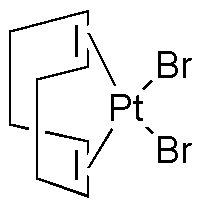Dibromo(1,5-cyclooctadiene)platinum(II) is widely utilized in research focused on:
- Catalysis: This compound serves as a catalyst in various organic reactions, enhancing reaction rates and selectivity, particularly in the synthesis of complex molecules.
- Coordination Chemistry: It is a key player in the study of coordination compounds, allowing researchers to explore metal-ligand interactions and develop new materials with tailored properties.
- Pharmaceutical Development: The compound is investigated for its potential applications in drug design, particularly in developing anticancer agents due to its unique platinum coordination chemistry.
- Materials Science: It is used in the development of advanced materials, including polymers and nanomaterials, where its properties can be leveraged to create innovative solutions.
- Environmental Chemistry: Researchers study its behavior in environmental applications, particularly in understanding its role in catalyzing reactions that can help in pollutant degradation.
General Information
Properties
Safety and Regulations
Applications
Dibromo(1,5-cyclooctadiene)platinum(II) is widely utilized in research focused on:
- Catalysis: This compound serves as a catalyst in various organic reactions, enhancing reaction rates and selectivity, particularly in the synthesis of complex molecules.
- Coordination Chemistry: It is a key player in the study of coordination compounds, allowing researchers to explore metal-ligand interactions and develop new materials with tailored properties.
- Pharmaceutical Development: The compound is investigated for its potential applications in drug design, particularly in developing anticancer agents due to its unique platinum coordination chemistry.
- Materials Science: It is used in the development of advanced materials, including polymers and nanomaterials, where its properties can be leveraged to create innovative solutions.
- Environmental Chemistry: Researchers study its behavior in environmental applications, particularly in understanding its role in catalyzing reactions that can help in pollutant degradation.
Documents
Safety Data Sheets (SDS)
The SDS provides comprehensive safety information on handling, storage, and disposal of the product.
Product Specification (PS)
The PS provides a comprehensive breakdown of the product’s properties, including chemical composition, physical state, purity, and storage requirements. It also details acceptable quality ranges and the product's intended applications.
Certificates of Analysis (COA)
Search for Certificates of Analysis (COA) by entering the products Lot Number. Lot and Batch Numbers can be found on a product’s label following the words ‘Lot’ or ‘Batch’.
*Catalog Number
*Lot Number
Certificates Of Origin (COO)
This COO confirms the country where the product was manufactured, and also details the materials and components used in it and whether it is derived from natural, synthetic, or other specific sources. This certificate may be required for customs, trade, and regulatory compliance.
*Catalog Number
*Lot Number
Safety Data Sheets (SDS)
The SDS provides comprehensive safety information on handling, storage, and disposal of the product.
DownloadProduct Specification (PS)
The PS provides a comprehensive breakdown of the product’s properties, including chemical composition, physical state, purity, and storage requirements. It also details acceptable quality ranges and the product's intended applications.
DownloadCertificates of Analysis (COA)
Search for Certificates of Analysis (COA) by entering the products Lot Number. Lot and Batch Numbers can be found on a product’s label following the words ‘Lot’ or ‘Batch’.
*Catalog Number
*Lot Number
Certificates Of Origin (COO)
This COO confirms the country where the product was manufactured, and also details the materials and components used in it and whether it is derived from natural, synthetic, or other specific sources. This certificate may be required for customs, trade, and regulatory compliance.


